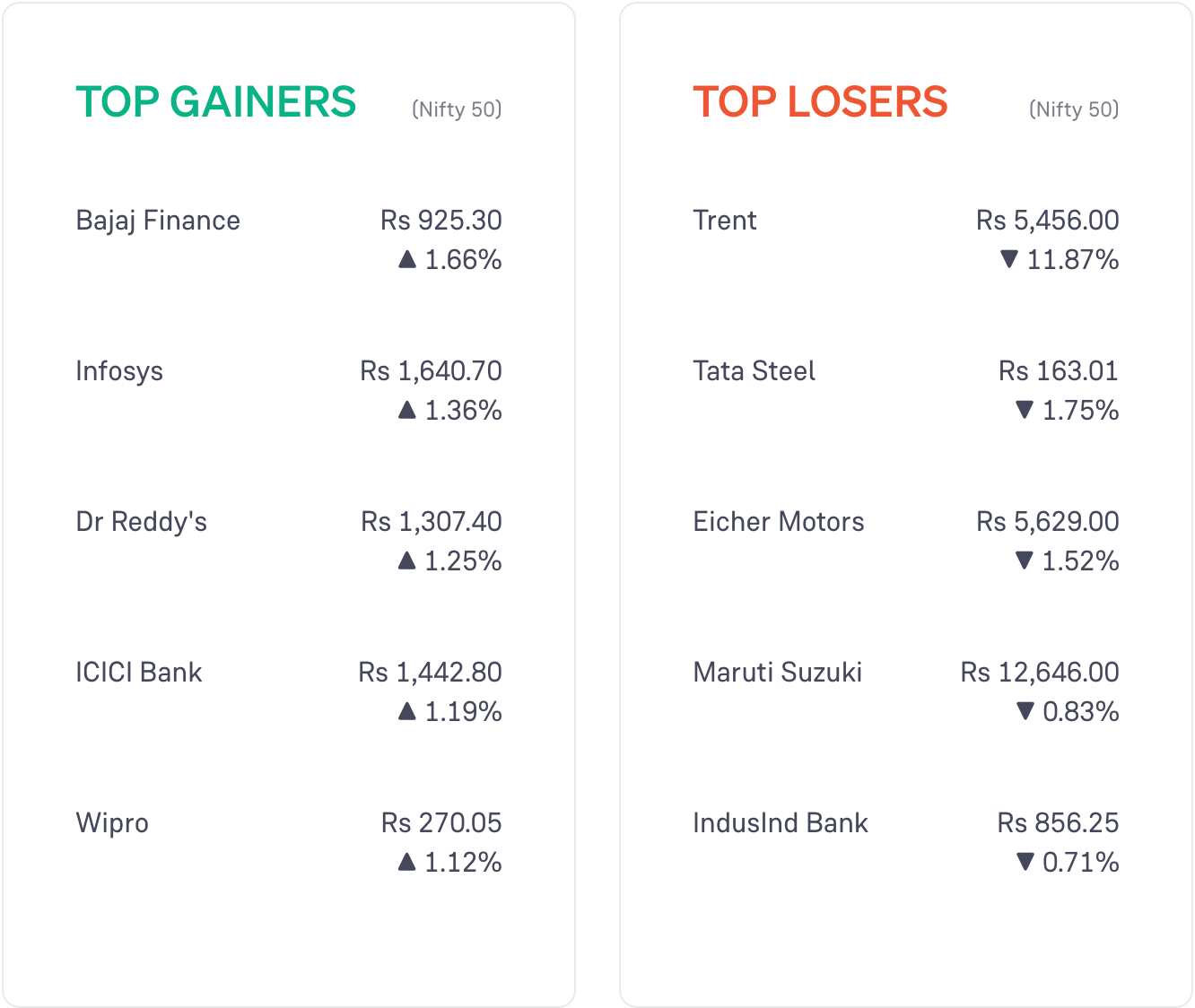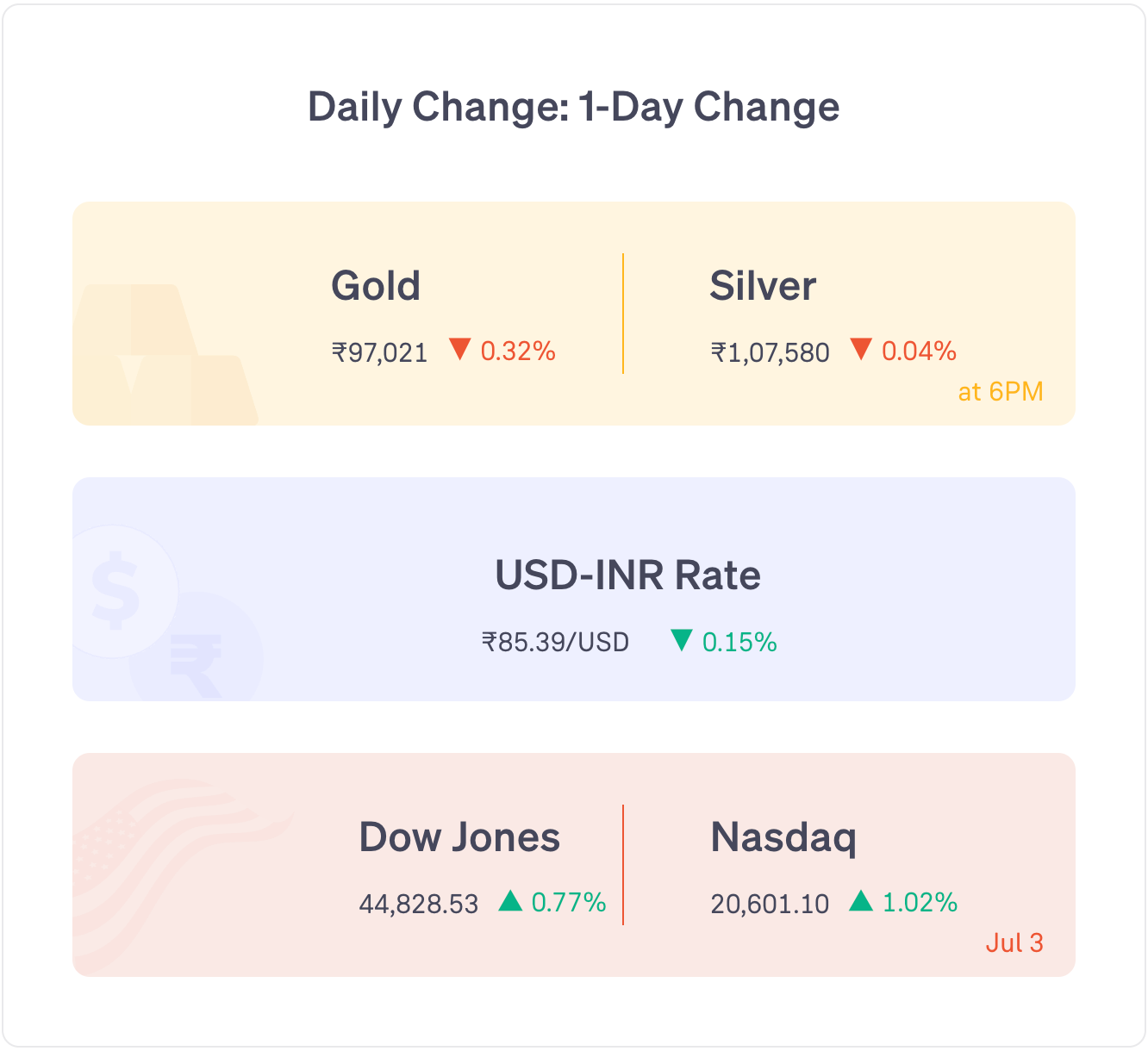SEBI bans Jane Street, US lifts export restrictions on chips software to China, & more
Friday, 4 July 2025
Markets opened above yesterday’s closing point.
Nifty 50 was volatile in the first half of the day. It rose in the second half of the day and closed in green.
Media stocks and consumer durables stocks rose the most today. PSU bank stocks and metal stocks fell the most.
Global markets: US markets rose and European markets fell. Asian markets showed a mixed trend.
News
SEBI has banned Jane Street Group, a US based trading firm, from Indian securities markets for allegedly manipulating the stock indices and making gains of Rs 4,843 crore unlawfully.
The US has lifted export restrictions on chip-design software to China, reversing the curbs announced earlier in May.
India has proposed retaliatory tariffs in response to the US imposing 25% duties on automobiles.
India’s forex reserves rose by $4.8 billion to $702.78 billion in the week that ended on 27 June.
India’s MSME sector now contributes to 30% of India’s GDP, 35.4% of the manufacturing sector and 45.73% of the exports of the country: Union Minister for MSME, Jitan Ram Manjhi.
Crizac IPO was subscribed 59.82 times. Retail subscription: 10.24 times. IPO closed for subscription.
Stocks Updates
Tata Steel: received a Rs 1,902 crore demand from Odisha’s mining department over alleged shortfall in mineral dispatch from its Sukinda mine.
Lupin: launched Ipratropium Bromide nasal spray in the US which has an estimated annual market size of $63 million.
Jindal Steel: received a 50-year mining lease for the Roida-I Iron Ore and Manganese Block in Odisha.
Tata Power: company subsidiary, Tata Power Renewables, rooftop solar installations rose 416% year-on-year to 45,589, which totaled to 220 MW in April-June period.
Bosch: received a customs order over misclassification of imported sensors, with a Rs 66.7 crore demand and Rs 29.6 crore penalty.
Auto Updates (June)
Maruti Suzuki: sales stood at 1.68 lakh units. Domestic sales were 1.30 lakh units and exports were at 37,842 units.
M&M: sales stood at 78,969 units, a growth of 14% year-on-year. SUV sales grew 18% with 47,306 units sold.
Tata Motors: domestic sales stood at 65,019 units. Commercial vehicle sales fell 5% year-on-year to 30,238 units. Passenger vehicle sales fell 15% year-on-year to 37,237 units.
Hyundai Motor: sales stood at 60,924 units including export sales of 16,900 units.
Eicher Motors: sales grew 22% year-on-year to 89,540 units. Exports grew 79% .
TVS Motor: sales grew 20% year-on-year to 4.02 lakh units. Two wheeler sales also grew 20%.
Ashok Leyland: sales stood at 15,333 units.
Escorts Kubota: sales grew 2.2% year-on-year to 11,498 units. Exports grew 114.1%.
Bajaj Auto: total sales grew 1% year-on-year to 3.61 lakh units.
Word of the Day
Upper Circuit
It is the maximum rise a stock can experience in one trading day
The limit is set by the stock exchange to control volatile price jumps and protect investors.
If a stock reaches this limit, trading for this stock is paused for a short time. This is done to prevent further price movements and prevent irrational buying.
There is also a lower circuit – the maximum fall a stock can experience in a day.
These limits are set daily as a percentage of a stock’s previous closing price.
6 Day Course
Theme: FIRE
Day 5: Friday
How can a few bad years of returns wipe out savings?
This fact is intuitively not understood by many but is crucial.
Let’s say a person has saved Rs 5 cr. This is invested in a small-cap fund for good returns.
The rate of withdrawal is 4% per annum.
So, when the value of the investment is Rs 5 cr, the person is able to withdraw 4% or Rs 20 lakh.
Now, a bad year comes and the investments fall by 50% (temporarily).
So, that year, the value of the investments is Rs 2.5 cr.
But the person’s living expenses are still Rs 20 lakh per year. So, in that particular year, the withdrawal is Rs 20 lakh from a total of Rs 2.5 cr.
Now, let’s say the value returns to its earlier level.
This would mean when it was down, the investor took out Rs 20 lakh from Rs 2.5 cr or the equivalent of Rs 40 lakh from Rs 5 cr.
This is a withdrawal rate of 8%!
A few years like this and the investment value will erode heavily.
This is why it is necessary to invest in different kinds of assets including low-risk investments from where an investor can withdraw in bad years.
Featured Question
Q. “If someone has no other sources of income except share market up to 4.5 lacks. , he will be liable to stcg”
Even in such a case, STCG tax and LTCG tax will be applicable.
This means that they will have to pay a tax of 20% as STCG tax; 12.5% as LTCG tax.
In case of equity LTCG, the first Rs 1.25 lakh gains are exempt from taxes.
But you still get rebates applicable on the tax slabs.
So, this means that any income up to Rs 4 lakh (new regime) or Rs 2.5 lakh (old regime) is exempt from tax.
So, if you are earning Rs 4.5 lakh as equity STCG in a financial year, you will not need to pay any tax on the first Rs 4 lakh of this income under the new regime.
Did you like this edition?
Leave a feedback here!






